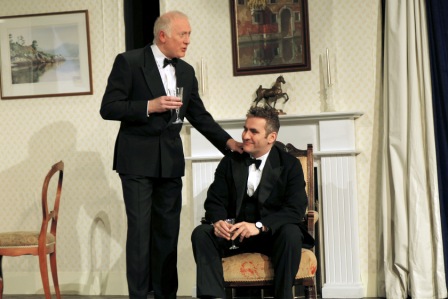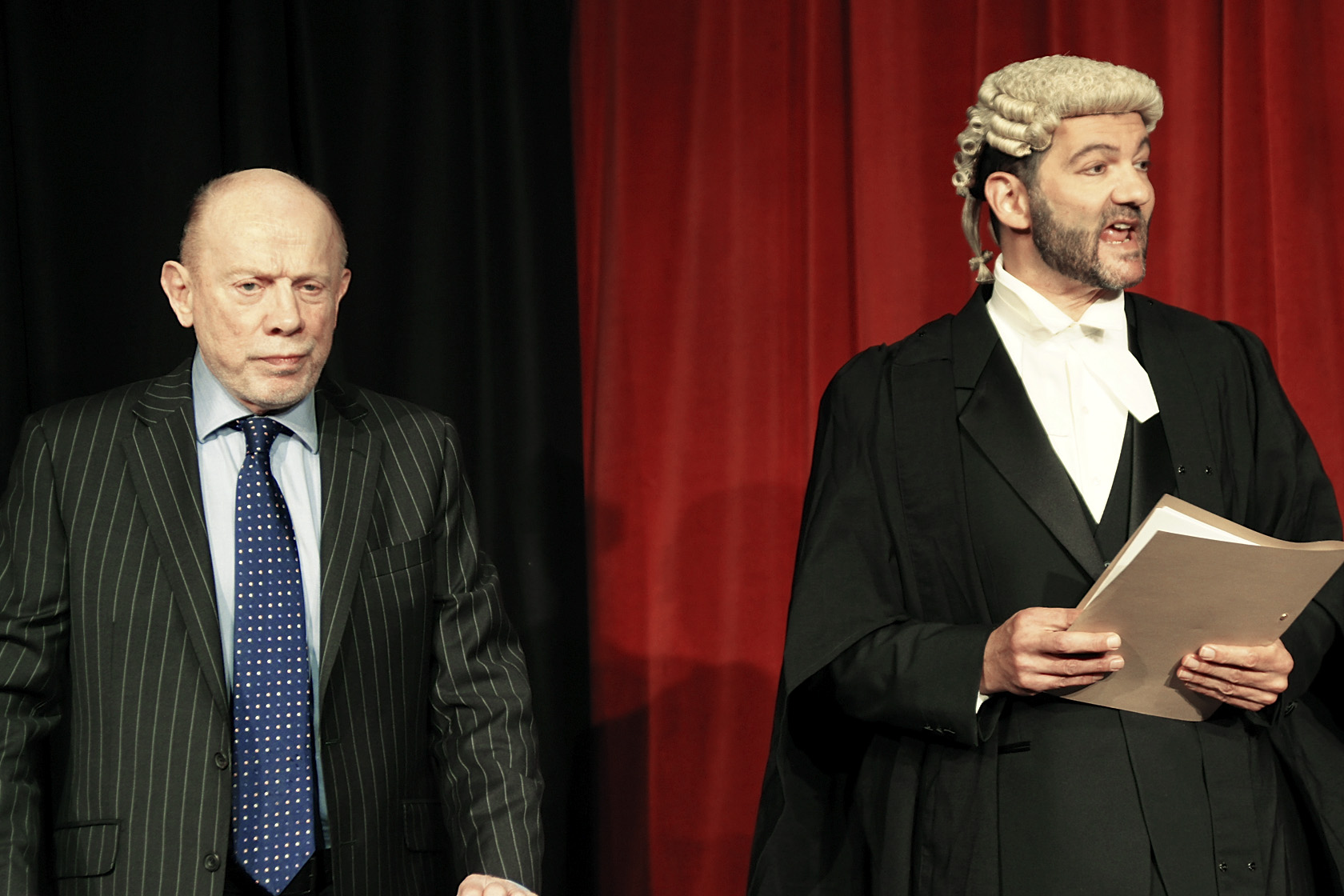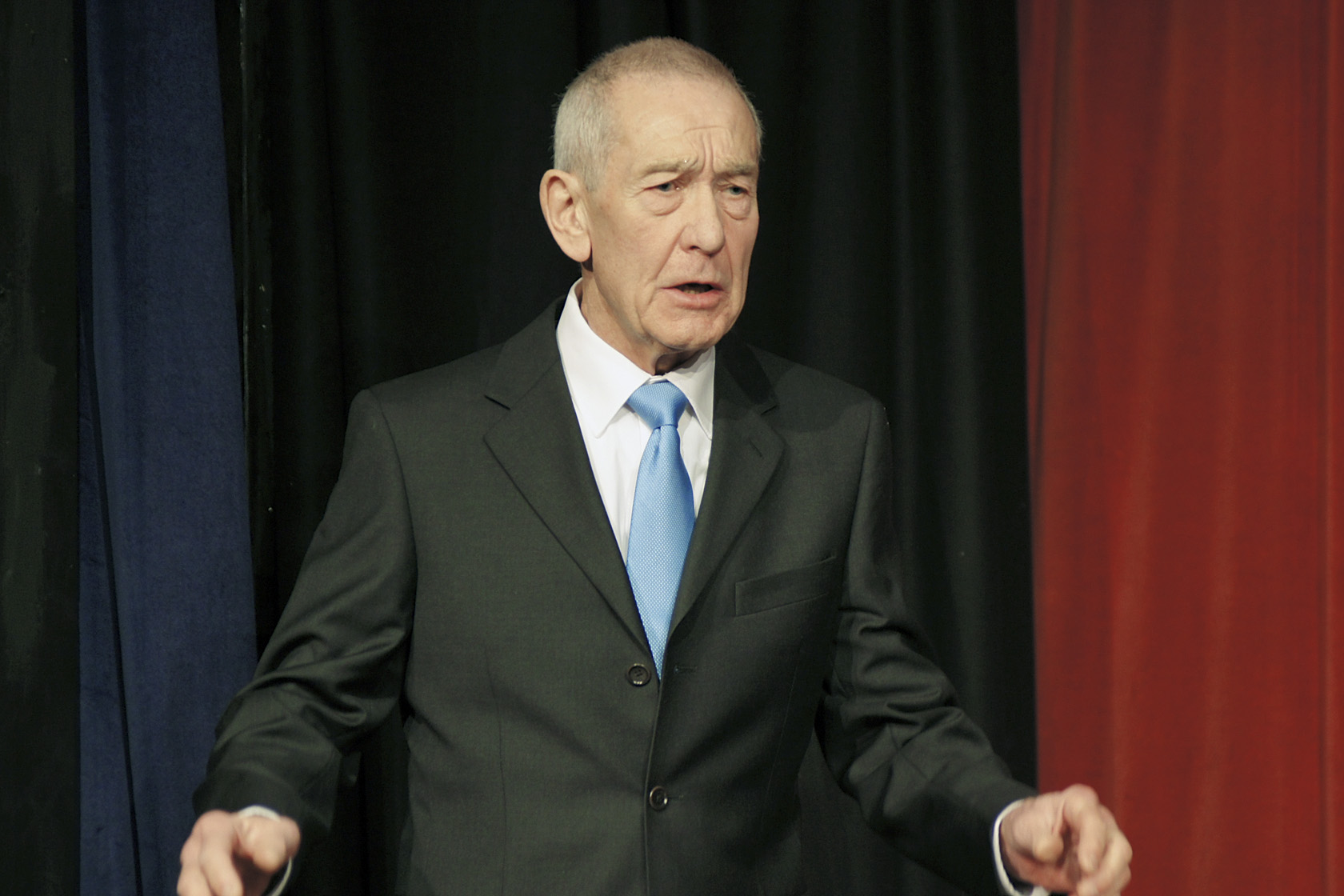|
|
|||||||||||||||||||||||||||||||||||||||||||||||||||||||||||||||||||||||||||
Click
here for more pictures of this play |
|||||||||||||||||||||||||||||||||||||||||||||||||||||||||||||||||||||||||||
|
|||||||||||||||||||||||||||||||||||||||||||||||||||||||||||||||||||||||||||
|
Click here for the
NODA crit for this play |
|||||||||||||||||||||||||||||||||||||||||||||||||||||||||||||||||||||||||||
|
The play opens with the actors ceremoniously entering the stage dressed in traditional QC and Judge’s robes. The Court Usher announces the beginning of the proceedings in such a way that it becomes immediately clear the audience is to be the jury in this case. We are reminded by Mr Justice Tredwell (Roger Barker) to remain impartial in the case. Barker’s portrayal of the Judge is distinguished, but not over-bearing. He emits an energy of being all-knowing. But Barker also emphasises the comedic moments in the play with the subtle sarcasm in his facial expressions and dead-pan delivery of his lines. The court proceedings begin with Anthony Blair-Booth’s (Howard Platt) opening remarks, which highlight his hatred for the defendant, Lord Metcalfe. Platt’s portrayal of the QC consumed by jealousy of Metcalfe’s success is understated; however, he accurately captures the humour of the character’s self-importance. Blair-Booth is a force to be reckoned with, who will not be defeated by his nemesis Metcalfe. As each witness is called, Lowe has cleverly staged the piece so that they enter from the audience. This enabled us to further feel as if we were in a real courtroom, judging the case. We first hear from Detective Chief Inspector Travers (Peter Huber), who is presented as slightly incompetent in the presence of Sir David Metcalfe. Huber accomplishes this by constantly looking at the notes in front of him before responding to the questions. This suggests his fear of accusing a powerful man of a crime he did not commit. We then meet the acrimonious Mrs Rogers (Eileen Stock), who makes no secret of her hatred of Metcalfe. Stock has managed to capture the prying nature of her character in a humorous manner. She serves as true comic relief in the somewhat monotonous procedures of the court. Next to the witness box is Dr Weeden (Phil Postings), the Metcalfes’ compassionate GP. Postings’ performance captures the sympathetic nature of the character. We then meet Lionel Hamilton (Richard de Berry), Metcalfe’s solicitor and ‘loyal servant’, as Blair-Booth bitterly comments. De Berry’s depiction of the lawyer is purposeful y stiff and straight-laced, which makes him the butt of other character’s jokes, particularly in the second Act. As we hear each witness, Lowe has skilfully ensured the realism of the court proceedings. Each QC is diligently making notes and referring to files and evidence. Mr Cole (Dave Hinkley) gophers around for the insufferable Blair-Booth and the Court Usher (Chelsea Camp) stares stoically into the distance during proceedings. Finally, we hear from Metcalfe himself. Throughout Act I, Andrew Rogers holds the audience in the palm of his hands, making us laugh at his sardonic jokes and comments about Blair-Booth. Rogers performs Metcalf with an air of theatricality that makes him believable as a successful QC. When he is in the witness box, Rogers also reveals moments of sincerity when speaking about his uncertainty about whether he was responsible for his wife’s death. As he speaks about her, Metcalfe’s obvious affection for his wife shines through. As the first act ends, Mr Justice Tredwell asks us to deliberate and reach our verdict. In the second Act, the curtains open to reveal the beautifully designed interior of the Metcalfe’s living room. Garry Cooper’s ability as a set designer is apparent as we see the contrast between the stark courtroom and elegant parlour. To match the sophistication of the set, Lady Metcalfe (Jean Cooper) is costumed in a stylish, 1980s, blue evening dress that matches the grace of Cooper’s portrayal of the character. As soon as Lady Metcalfe appears on stage, there is a sense of brightness that has not previously been seen in the play. Cooper is charming as Millie and evokes empathy from her audience. It is apparent through her small groans and rubbing of her muscles that she is suffering unbearably. However, Cooper hides this from the other characters, showing her skill as an actress. It is only with her husband that she is able to let her guard down. Rogers also transforms into a jester in this Act, entertaining his wife and guests with amusing quips, poetry and his silly, but hilariously accurate Welsh accent. It is also in this Act that we see Junior Council, Robert Pierson (Neil Grosvenor), come alive. Grosvenor’s almost child-like portrayal of the character shows that he looks up to Metcalfe as a father figure and mentor. In this Act, we see the tenderness in the couple’s relationship as well as their quirky sense of humour. Rogers’ and Cooper’s chemistry on stage is exceptional and enjoyable to watch. It is especially engaging to see the characters ‘play-acting’ as the nosy Mrs Rogers hovers nearby. A particularly beautiful moment between the characters is when Metcalfe is helping Millie to bed and the stage goes dark, with the exception of the light in the hallway. In this moment, lighting designer Terry Tew has captured the tenderness and sadness in the couple’s relationship. In a crucial moment in the production, Millie blatantly asks Metcalfe to help her end her life. Lowe has handled this with a sensitivity that makes the audience empathise with the characters. However, it is unclear in this moment how Metcalfe will respond to his wife’s plea, which is just as the director wants it. In the final scene in the play, Metcalfe has been acquitted of his wife’s murder and invites the starchy Lionel Hamilton to call. He finally reveals that he murdered Millie in order to relieve her suffering. In a dramatic ending, Metcalfe poisons himself with the same pills he used to end his wife’s life. Mary Lowe’s production reminds audiences that it
isn’t always important who committed a crime, but why. The first act
could have benefited from some cuts to the script; however, the second
half of the play is engaging and causes the audience to question their
own ethics and morality. And isn’t that what good theatre should do? |
|||||||||||||||||||||||||||||||||||||||||||||||||||||||||||||||||||||||||||



